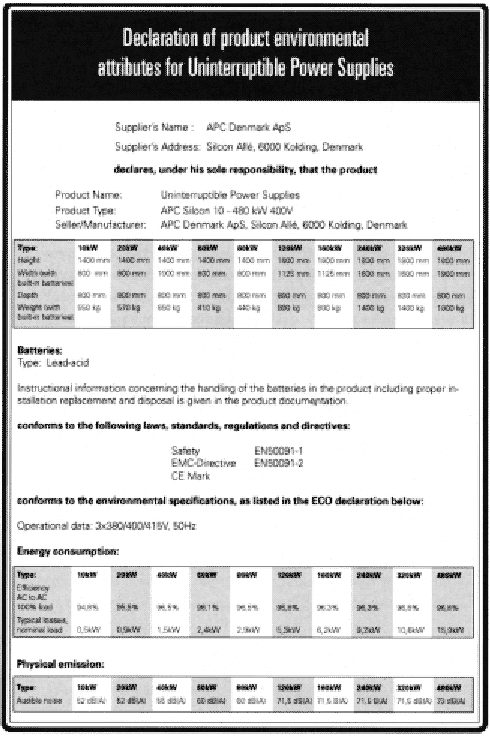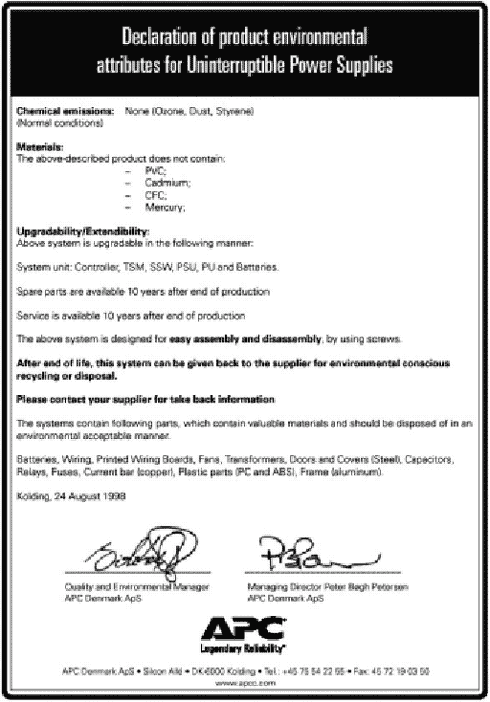Manual on Product-Oriented Environmental Work
4 Environmental product declarations
This tool contains a short overview of the international work within environmental product declarations, followed by some tips on preparing an environmental product declaration for one or more of your products.
4.1 About environmental product declarations
Environmental product declarations are basically neutral in their statement. An environmental product declaration does not contain a positive statement about a product, but simply provides information on the product's environmental performance so that the user himself can assess the product's environmental properties and compare with those of similar products.
Environmental product declarations can be prepared not only for finished products, but also for raw materials, semimanufactures and services.
Internationally, one differentiates between Type II and Type III declarations (Type I are eco-labels). In 1999, ISO adopted a standard (ISO 14021) for "Self-declaration environmental claims" - the so-called Type II declarations. The standard describes how the most common terms and symbols are to be used. It is stated in the standard that organisations using the claims must have the documentation on which they are based in order.The documentation need not be LCA based and impartial third party control is not required. Self-declaration claims can be regarded as a type of environmental product declarations, and several Danish companies have already prepared them - see the example from APC Denmark at the end of this chapter.
Type III are the real environmental product declarations.They are based on LCA data. They are also checked by a third party and are therefore regarded as more reliable than self-declaration claims. In the spring of 2000, ISO issued a technical report (ISO TR 14025), which is in the nature of a guide but is not an actual standard. If you want to prepare yourselves for the requirements in a Type III declaration, it would be a good idea to read this technical report.
4.1.1 Environmental product declarations in other countries
Sweden and the USA/Canada are the only countries that have so far established schemes for certification of environmental product declarations.
For further information on the Swedish scheme, which is managed by the Swedish Environmental Management Council, see the council's website: www.miljostyrning.se/epd.
Scientific Certification System (SCS) stands for an American system for environmental declaration.You can contact SCS via its website: www.scs1.com.
Norway, Germany, the Netherlands and Korea are looking into the possibilities of establishing national certification schemes for environmental product declarations. In Norway, a 3-year pilot project is planned, with the Confederation of Norwegian Business & Industry (NHO) in overall charge of the system.
4.1.2 The situation in Denmark
In Denmark, too, preliminary studies are in progress to clarify how a Danish certification scheme can be established. The Danish EPA sent out a proposal for consultation in 2000. Denmark is also participating in a Nordic project to clarify various questions, including how the existing/coming schemes in the Nordic countries can be coordinated.
Examples of other Danish initiatives are given below:
| In 1996/97, the Danish EPA funded a project aimed at qualifying the discussions concerning environmental product declarations. In the project, proposals were prepared for environmental product declarations addressed to professional users and private consumers (Environmental Product Declarations,Working Report No. 47, 1997). | |
| A project now in progress for the Danish Ministry of Housing and Urban Affairs is investigating the possibilities of environmental declaration of building products. The target group here is the companies designing the products. For further information, contact the Danish Building Research Institute: www.sbi.dk. | |
| For the Danish EPA, a project is at present in progress on environmental product declarations for consumer electronics, the target group here being private consumers. For further information, contact dk-TEKNIK. | |
| The Danish IT Industry Association has tried to help its members by issuing a guide on the formulation of an environmental product declaration for copying machines, printers, fax machines and PCs. The declaration, which was published in 1998, is intended to answer the most common customer questions and will be regularly updated by the association in step with new environmental knowledge or new views from authorities, users or other interested parties. The declaration is a Type II declaration. Further information can be obtained at: www.itb.dk. |
4.2 Good advice on preparing Type II declarations
If you want an environmental product declaration that meets the requirements of a specific scheme - for example, the Swedish scheme - you must naturally follow the guidelines in the scheme in question.
If, on the other hand, you want to prepare your own uncertified Type II declaration (Self-declaration claims), you can base it on the ISO 14021 Standard. In addition, you should consider:
| what expectations you have encountered so far and what the future can be expected to bring | |
| who your target groups are and the degree of detail the target groups in question can cope with. |
4.2.1 The expectations
Part A, Chapter 3, of the manual provides help in mapping present and future expectations concerning your products. If you have many different products or the expectations concerning your products vary greatly from product to product, you may have to select a product before you can create an overview of the expectations.
If you want to make a start on formulating an environmental product declaration that is primarily intended to answer the most common questions concerning the product, it is best to start with the questions you yourselves have asked.
If you have not previously systematically registered expectations concerning your products, it would be a good idea to check these and establish a procedure in your environmental management system that will ensure that all future enquiries concerning the environmental aspects of the product are registered (see Chapter 5).
4.2.2 The target group
It is also important to define the main target group for the declaration. Is it professional buyers with some background knowledge of environmental matters or buyers who have little or no knowledge in this area?
It is always a good idea to consult the users of the declaration when deciding what data in the declaration should be presented. It is important always to ask yourselves: "Can our target group understand and use the information?"
4.2.3 Formulation of the environmental product declaration
The preparation of an environmental product declaration should preferably be an ongoing process in which the declaration is expanded and amplified as you learn more about the product's life cycle and environmental impacts.
It is a good idea to establish a direct target for the appearance of the first declaration and a long-term target for what the declaration should in time include.
Often, a declaration will at first contain answers to a number of environmental questions that can be directly answered with the knowledge that already exists in the company and then be expanded to include the result of a life cycle assessment.
In many of the Type II declarations that exist today, the companies have chosen to focus on substances that the product does not contain (PVC, lead, cadmium, ...).
An important consideration in the formulation of a declaration is also that the users must be able to access the underlying data.You must be able to document all the claims in an environmental product declaration if asked to do so by a user.
This consideration is particularly relevant in the case of products with a secret composition or secret production methods.
4.2.4 Data collection and documentation
The amount of data to be collected will depend to a great extent on the chosen formulation. If your environmental product declaration is to be based on a life cycle assessment, collecting the necessary data will be the task that requires most resources.
It is a good idea to set up procedures for registration of data in the environmental management system (see Chapter 5). Systematic registration of the data used is necessary as documentation of the result of a life cycle assessment. By systematically registering the data collected, you also enable reuse of the data in later assessments.
Systematic registration of life cycle-based data is also essential for the environmental product declaration to be checked by a third party and thus become a so-called Type III declaration.
4.2.5 Guide on environmental marketing
Regardless of how an environmental product declaration is prepared, you must remember that the Marketing Act must be complied with.
The Consumer Ombudsman has prepared a guide on environmental marketing, which explains briefly how environmental claims can be used in the marketing of products without violating the Marketing Act.
It is stressed in the guide that all claims must be documented and that generalisations (such as environmentally sound, eco-friendly) must not be used without a thorough report on the entire life cycle of the product that shows that the product has a considerably smaller environmental impact than other products in the same product category throughout its life cycle.
The guide can be purchased from the Danish Consumer Council, phone +45 32 96 07 11 or can be seen on the Internet at: www.fs.dk/kg/kg1393.htm.
4.2.6 From environmental product declaration to product improvements
The reason for improving a product's environmental properties can be a wish to improve critical parameters in the environmental product declaration or a general wish to reduce the product's environmental impacts during its life cycle.
The knowledge gained concerning a product's environmental impacts by working with the life cycle approach will often act as a spur to the work of improving the product's environmental properties.
4.2.7 Supplying environmental product declarations
Prepare a procedure in your environmental management of quality management system for supplying environmental product declarations in connection with marketing, customer enquiries and other enquiries as a means of spreading awareness of the company's environmental product declarations (see Chapter 5).
Examples of Type II environment product declaration (ACP Denmark ApS)

